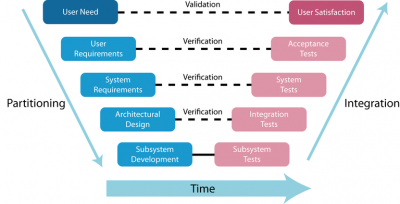What this course is about
This module provides an understanding of the processes that make up the different stages in the lifecycle of a system. Students learn about adaptation processes (tailoring), the different types of lifecycle models and the diverse lifecycle stages and their interrelationships. It develops an appreciation of the context in which the lifecycle of the development of a system is relevant and to the business in general. The course introduces aspects to consider pre- project, within a project and post-project at both 'product' and organisational level. Case studies are used to illustrate the application and relevance of taught concepts, while students relate learning to their own experience through group exercises.
By the end of this module, the student will be able to:
- Understand the processes involved in the lifecycle of a system, especially in development
- Identify the project and organisational context of the development lifecycle of a system
- Understand the centrality of process and the benefits of having an organisation that works based on processes
- Understand the importance of a tailoring process and the factors that determine it
- Appreciate the human aspects and influences in the organisation throughout the lifecycle
- Understand key process areas in the lifecycle of a system
- Understand the importance of early integration in the development lifecycle of a system
- Understand the importance of concurrent engineering
- Appreciate importance of the "Design for" constraints of design and when to consider them
- Appreciate the need to optimise processes through continuous improvement
Teaching mode
The module usually runs anually and is taught through a mixture of lectures, interactive discussions and group exercises which facilitate networking among peers.
Accreditation
This module is 15 credits. It is a core module on the MSc Systems Engineering Management and an optional module on the MSc Technology Management and the MSc Management of Complex Projects.
Module Context
Why the lifecycle matters
There are important benefits to understanding what the lifecycle of a technology is and using that understanding to align the relevant processes and teams. The lifecycle of any technology or system includes the entire spectrum of activity involved in development, from the identification of a need through to dealing with obsolescence and disposal. As the development progresses, there will be interactions between activities in different stages and this leads to 'concurrent engineering' in which progress is made across various stages of the lifecycle in parallel, enabling non-functional requirements such as manufacturability to be fed back into the design process.
Tailoring the lifecycle
Although we talk about lifecycles in a generic way, it is evident that the most appropriate type of lifecycle will depend on the type of project, the technology involved, the particular constraints, and the state of maturity of the organisations involved. That is why it is essential to have proper tailoring processes to choose the lifecycle type best suited to the circumstances and the project.
The specific activities and the duration of each will vary depending on nature, complexity and purpose of the system as well as the factors above. Even with appropriate tailoring in place, requirements may change and processes need to be robust to handle these changes and also to allow for improvement. Our Principles of Systems Engineering Management, which underpin all of our teaching, therefore advocate a flexible approach to system development.
Stages in a lifecycle
When developing complex technological products, it helps to apply a 'systems approach', which ensures special attention is given to certain key areas. The life of the product can be divided into life cycle stages as shown in the 'V-diagram below'. After the product is accepted by the customer, it is operated, maintained and ultimately disposed of, often to be replaced by the next generation of product.

 Close
Close


